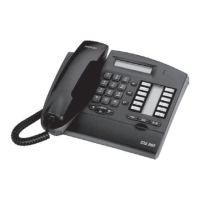9
SPLITTINGCALL SERVER : TELEPHONE FEATURES
Ed. 04 1/4Réf. 3EH 21000 BSAA
File
SPLITTING
DESCRIPTION
The splitting mechanism enables a user to dial a number on an analog trunk line or behind a PABX,
without having to wait for any dialing splits.
It is accessed:
- by manual dialing
- by automatic dialing (last number redial, temporary memory number, speed dial number)
Splitting can be of two types:
- tone detection: TONE in the splitting prefix table
- pause: PAUSE in the splitting prefix table.
The mechanism applies at three levels:
- During line seizure:
• if the splitting is TONE, dialing is possible as soon as the PABX has recognized the tone trans-
mitted by the trunk during a validation time-out. If, after expiry of a time-out, no tone has been
recognized, the system releases the line.
- if the splitting is PAUSE, dialing is transmitted after expiry of a programmable time-out, (diffe-
rent for private or public trunk lines).
- Intermediary splitting prefixes:
Dialing according to the prefixes in the splitting prefix table, is transmitted after tone detection or
after a splitting time-out with the same principles as for the line seizure.
- Splitting prefixes defined in the personal or collective speed dial numbers:
A personal or collective speed dial number can have one splitting character (symbolized by "!"). The
splitting method used (TONE or PAUSE) is the one programmed in the splitting prefix table.

